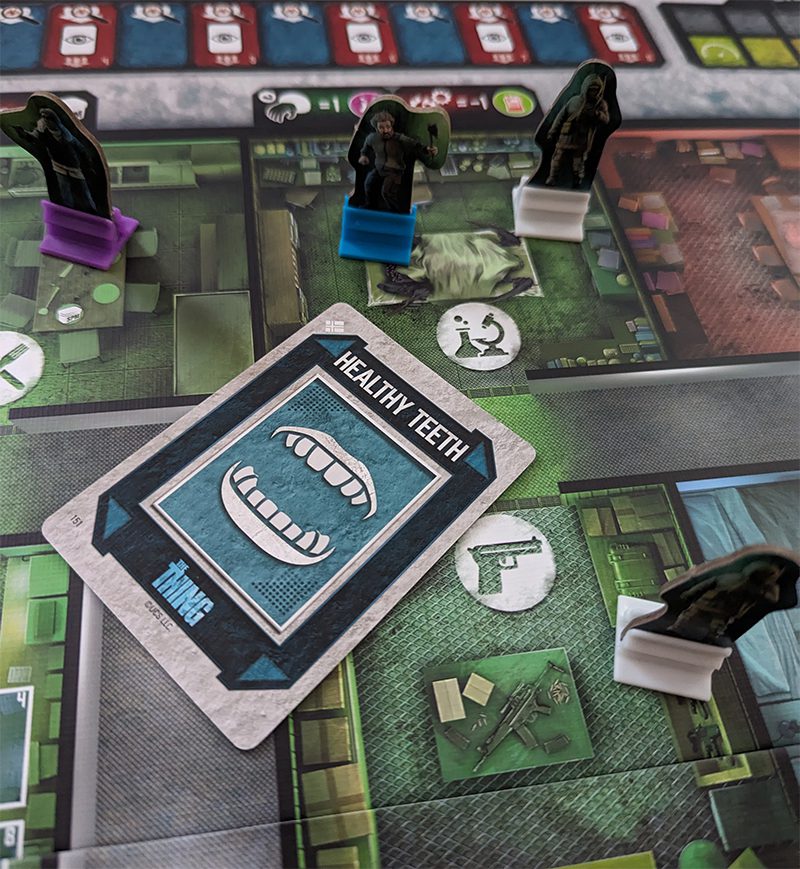Disclosure: Meeple Mountain received a free copy of this product in exchange for an honest, unbiased review. This review is not intended to be an endorsement.
Board game expansions offer a refreshing way to breathe new life into beloved games. Through new mechanics, characters, scenarios, or game pieces, expansions often add excitement to the gameplay experience of the original game. They can add depth and complexity, catering to experienced players seeking new grounds to discover and conquer. Expansions are also a good way to fix issues with the original game after getting plenty of feedback from the players due to the hundreds, if not thousands, of game sessions.
In a perfect world, an expansion would always be a welcome addition to anyone’s library for their favorite game. However, we are not a perfect world. Some expansions are questionable and, dare I say, should be avoided. The Thing: Norwegian Outpost, unfortunately, falls into this category, nose first. I know I’m risking reading retention by stating this in the intro paragraphs, but I had to get off my chest.
It’s a surprise that I say this too, because it tries quite hard to stick to the original principles of the base game. You still have the Thing going around, infecting people with encounters with the eventual reveal. Dogs, now replaced with NPCs, roam around the base, causing problems for everyone. The non-infected players are working together to escape and make sure the Alien doesn’t tag along.

When Ambition Overshoots
Actually, that’s incorrect. One of the major changes in this expansion is that players can win on their own without the help of others. Any Human players that escape with a vehicle without the Alien hitching a ride will “win” and are out of the game, but the game still continues. It’s actually much easier to escape with the vehicles since they do not need to be repaired like in the original game.
The reasoning behind this end goal is straightforward: it draws inspiration from the 2011 prequel film. In that movie, the humans intentionally sabotaged their own vehicles to prevent the Thing from escaping. Within the context of the game, this translates to the Sabotage action card being available for use by the Human players rather than being exclusively used by the Thing player as in the original game. While this is a neat idea, it comes across as extra steps for the game’s “meta” that weren’t necessary in the original.
I also despise the existence of this end goal because it smothers one of the hallmarks of the original game. Team play was absolutely essential despite the Thing’s existence dissolving everyone’s trust with each other. It’s the importance of working together that caused everyone to have engaging altercations during the Rec room phase and kept the blood pulsing throughout a session. With the new end goal being far more selfish, it’s hard to see this as an improvement over the old ways.
Another notable addition to the end game is the dog track, basically imposing a round limit. However, this round limit can be extended by acquiring a sniper rifle weapon from the arsenal. This mechanic serves as an alternative win condition for the Alien player, enabling them to pursue the hide-and-seek strategy. While an interesting concept, the original game already incorporated a “soft” round limit through the depletion of resources, making it a more organic approach.
Gimmicks Over Substance
Perhaps the most divisive addition is the UFO escape mini-game. If the Thing player manages to escape with a vehicle, they retreat to their UFO. At this point, the remaining Human players transition to a separate game with its own ruleset. The main board is abandoned in favor of the UFO board, where players scramble to collect Departure tokens before the Thing secures them. The entire sequence involves the Alien player choosing which sectors of the UFO to go to, with the Human players following suit. This mini-game is hardly an emulation of the cat-and-mouse dynamic in the base game.
With a cast of new characters, one would assume there would be new powers to play with. This isn’t the case here, as they simply re-use the powers from the base game. The weapon and item cards aren’t that much different either. The grenade replaces the molotov cocktail and dynamite to set fires to rooms or fight the Thing. There is the new sniper rifle, as I previously mentioned, and a new use of the Flashlight.
Finally, something positive I could talk about. In the prequel movie, it is revealed that the Thing cannot replicate metal, meaning individuals with metal fillings in their teeth are confirmed to be human, while those with healthy teeth could potentially be impostors. In the context of the game, the Flashlight serves as a new method to test other players, reflecting this concept. This mechanism introduces an intriguing twist to the traditional “check” systems found in most social deduction games.

Missing the Mark
Although this new change is nice, it fails to compensate for the numerous shortcomings present in this expansion. The original game itself had its fair share of issues, such as an over-reliance on player skill and a poorly written rulebook. However, this expansion exacerbates these problems further by introducing additional fiddliness and complexity.
Expansions are often tailored towards experienced players seeking more depth, yet this particular expansion heads in the wrong direction. Whereas the original game made sensible design compromises to capture the essence of the 1980s film, this expansion concedes too much ground in its attempt to imitate the style of the 2011 prequel movie.
The Thing: Norwegian Outpost expansion misses the mark in delivering a worthwhile addition to the beloved base game. By compounding existing issues with increased complexity and a departure from the core game’s strengths, I simply don’t see a reason why any fans of the original game would want this one. Its additions are gimmicky and intricate while diluting the core experience. Stick to the base game.











